For some shoppers, buying fake goods can be about as good as the real thing.
It's not clear how big the global counterfeit market is, but research suggests it costs American retailers a sizeable amount of lost revenue. Per a 2018 report from the U.S. Government Accountability Office, the Customs and Border Patrol seized an estimated $1.38 billion worth of knockoff merchandise in fiscal year 2016 alone.
Counterfeit sales were a problem long before digital marketplaces emerged. Now, online sales of fake merchandise have become a growing problem for retailers. While some consumers mistakenly purchase knockoff merchandise, a notable number of consumers find it perfectly fine to buy fake goods and have done so on purpose, multiple experts told Retail Dive. To combat online counterfeit sales, retailers face the problem of addressing not only the appeal of affordable knockoffs but also the rise of third-party sellers on online marketplaces. And they'll likely need international law enforcement agencies' help to effectively do so.
Per a May 2019 report from the International Trademark Association on Gen Z counterfeit consumption habits, 71% of survey respondents purchased counterfeit products in the past year, and 35% anticipated buying fewer fake goods in the future. The majority of Gen Z consumers (64%) said they had a positive experience with the purchase of a counterfeit product, the survey found.
"Realistically, these people that are buying counterfeit goods are never going to buy the legitimate good."

Piers Barclay
Chief Strategy Officer, Incopro
However, the problem of buying fakes isn't unique to Gen Z shoppers. An Incopro report found 26% of shoppers have mistakenly bought a counterfeit good, and 52% of consumers have lost trust in a brand after buying a fake item online. On the other hand, the report also found that 32% of consumers said they thought buying fake items like clothing, jewelry and leather goods as acceptable.
The hesitance to discuss the online counterfeit goods problem differs from one company to another, but luxury brands generally are anxious about the erosion of their reputation with consumers if they acknowledge fake goods, said Piers Barclay, chief strategy officer at Incopro. For cosmetics companies or other product manufacturers with health and safety concerns, they're worried about an overall loss in confidence in their product, he said.
For some consumers, though, buying counterfeit goods is a way to align themselves with the status of the brand without paying full-price, especially for luxury goods, he added.
"With the rise of social media, with the rise of Instagram and people trying to show very aspirational lifestyles, that's a big driver of it," Barclay said in an interview. "Realistically, these people that are buying counterfeit goods are never going to buy the legitimate good."
Whether consumers see the purchase of counterfeit goods as a bad thing could depend on the circumstances behind the purchase, experts told Retail Dive. Consumers buying Baby Yoda Dolls on Etsy from individual merchants who are fans of Disney Plus' streaming series, "The Mandalorian," may not have much sympathy for a major corporation like Disney, nor are they concerned about any safety issues arising from a handmade product, said Jed Nelsen, senior compliance manager at e-commerce growth company etailz.
"What those sellers are doing — they're technically selling images that are copyrighted by Disney that Disney owns the rights to make money," Nelsen said. "In another sense, these vendors are selling quality products that are great ... And you could even argue that Disney is seeing a benefit to it, because the merchandise is encouraging people to watch their show."
Disney eventually created Baby Yoda merchandise, but the products are available through pre-order only until March 1, long after the 2019 holiday shopping season, The Verge reports. As of Feb. 7, Disney's Mandalorian plush doll, known only as "The Child," is sold out, per Disney's website.
While some see buying fake merchandise as having no negative impact, consumers may not be aware of the risks associated with doing so, such as lost tax revenue as well as supply chain problems like child labor, human slavery and organized crime, Barclay said.
Barclay noted that Canada Goose has communicated with consumers online about its supply chain and the importance of having an ethical supply chain, so they can know where their merchandise originated. In addition to the company's polar bear environmental sustainability campaign, the brand has emphasized on its website that its fur, wool and down are ethically sourced. However, those claims have previously been called into question, resulting in the brand reportedly pulling a video about its down traceability.
While some brands view counterfeit goods and an ethical supply chain as merely a legal matter, the brands that invest in communicating the downsides of knockoff merchandise do a better job of explaining the significance of issues, Barclay noted.
"You're still kind of relying on that consumer being proactive and wanting to check things," Barclay said. "Those [retailers] that view it as part of their marketing, part of their duty of care to their consumers, invest much more into it."
As for brands that sell their goods through online marketplaces, the brands have to figure out how to effectively tell their brand story on these platforms, said Keri Rhodes, marketing director at etailz, noting that Amazon has been encouraging brands to steer their representation on the platform to reduce counterfeit sales. Brands could take advantage of emerging tools like Amazon Live to spend a segment explaining the downsides of counterfeiting, Rhodes said.
Online marketplaces have launched initiatives aimed at addressing counterfeit sales, Barclay said, pointing to Amazon and eBay's programs as examples. Other online platforms aren't as responsive to takedown requests, according to Barclay.
"Platforms typically make money from transactions, and any transaction is a good transaction to them it seems," Barclay said.
However, such efforts can be cumbersome for retailers and brands. For example, Amazon's Transparency program, which provides transparency codes designed to track products from manufacturing to sale, allows customers to learn about the product via the transparency app on their phone and prevent buying counterfeit products. On the other hand, it costs retailers money and time to be onboarded into the program, Nelsen said.
Besides the costs of participating in such efforts, marketplaces could also make more of an effort to verify the identity and location of third-party sellers and make it easier for law enforcement to locate third-party sellers pushing fraudulent products through the platform, said Jason Brewer, executive vice president of communications and state affairs at the Retail Industry Leaders Association.
The Trump Administration has recently made efforts to combat the online sale of fake merchandise. In April 2019, President Donald Trump issued a memorandum aimed at curbing counterfeit sales on online marketplaces. In January, the U.S. and China signed an agreement promising to collaborate on stopping the manufacturing and sale of counterfeit goods, part of which aims to examine the knockoffs sold on e-commerce platforms. And as recently as Jan. 31, Trump signed an executive order to "protect consumers, intellectual property rights holders, businesses, and workers from counterfeit goods."
"Right now, it's too easy for one of these third-party platforms to sell through one of these platforms, and there's not a lot of regulation on the government's side," Brewer said, prior to President Trump's executive order. "There's not a lot of accountability from the platforms."
In the interim, brands have taken it upon themselves to go after online marketplaces that sell fake merchandise. Williams-Sonoma filed a lawsuit in 2018 against Amazon for selling what it called "knockoffs" of the West Elm brand. In November 2019, Nike notably pulled its products from Amazon after a two-year trial period with the company.
"Maybe Nike's big enough that they could pull it off, though I would be skeptical given the growth of marketplaces and how many customers are shopping for your products on those platforms," Nelsen said.
Until online platforms do a better job of combating online counterfeit sales, brands are weighing whether to follow Nike's lead and pull their products from these marketplaces altogether, Barclay said.
"Brands are getting increasingly frustrated with this issue," Barclay said. "If the platforms don't do something about this, there's a risk that the major brands that drive a lot of business to them will stop selling through them."

















